Commercial / B2B Industries
Our consultants have worked across the value chain in industries that sell to other businesses. We bring diverse experience from traditional manufacturing to enterprise software to our engagements, applying lessons learned and proven models adapted for our clients. Our clients benefit from our successes scaling businesses from early stage to high growth to multinational.
Actionable Strategies has a track record of success in major markets that it has brought to emerging markets. Combining strategy, operational excellence and technologies that enable business strategies has enabled our clients to outperform. Pragmatic application of the most suitable approaches is one of the reasons clients choose to work with us.
 This Fortune 500 company provides services from 12 major operating centers running Cloud software. Human capital from 20 regions serves over 700,000 clients in 112 countries, generating revenues of $12 billion.
This Fortune 500 company provides services from 12 major operating centers running Cloud software. Human capital from 20 regions serves over 700,000 clients in 112 countries, generating revenues of $12 billion.
To ensure sufficient staffing was available for key functions, a model was created to predict staffing levels vs. future plans. Data about trainees and new hires was captured to predict anticipated attrition early in an employee’s tenure. Workforce turnover rates drove the model for more experience workers.
The client was able to limited the number of unfilled positions in key roles by using the predictive model.
The predictive model used historical rates for attrition and captured data to enable the model to be recalibrated. This process was automated and data was continuously updated. Executive dashboards and visual management reports were created including funnels and maps. After a successful pilot, the predictive model and visualizations were deployed across the enterprise.
Clients should consider the following important lessons from this project.
- Align the representation of information to the audience; front-line leaders require different information than executives
- Clearly present the situation through visualizations so that users do not need to interpret information; data should support the conclusion
- Utilize metaphors that facilitate understanding such as gauges and other familiar representations
- Predictive models should utilize historical data if available; as data continues to be gathered, the models should recalibrate themselves
- Implement data quality management processes to ensure that the models continue to provide accurate predictions
- Pilot first and refine the approach and visualizations based on direct stakeholder feedback
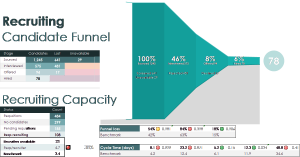
In the example above, a candidate funnel was used because the sales-driven organization understood a sales funnel. Stoplight indicators highlighted which areas required attention. Direct work with stakeholders results in a final visualization after a number of iterations.
This industry leading company provides processing of HR data and outsourcing on a global basis. It has amassed the largest independent data sets encompassing just under a million companies and over 30 million people. Despite having 60 years of history, the company was lagging smaller competitors in the area of analytical capabilities.
Actionable Strategies built the foundational organization, processes and technology models used by the client today to provide products, solutions and advisory services to their customer base. The initial data science work enabled the client to understand what assets could be delivered to the market and also used internally.

Solution Approach
An evolutionary approach enabled the client to move from Plan and Pilot activities to the Growth stage.
- Pilot deployment delivered initial capabilities to support exploration by data scientists
- Initial exploration supported pilot product development and led to an initial release of an analytics product
- Subsequent efforts led to a structured data repository supporting sustainable product development and exploration by internal users
Key Technology Approaches
A sustainable model was established and built incrementally.
- Shared Hadoop Data Lake for all stakeholders
- Anonymized personally identifiable information, protecting privacy and avoiding data spills
- Aggregation of data for privacy but also to facilitate very fast analytical performance
- Common interfaces (e.g., JSON) to enable product development across platforms
- Support for enterprise standard toolsets (R, Oracle, Cognos, D3, HighCharts) and end-user exploration tools (Cognos, Tableau, Microsoft Power BI and Excel)
Initial data science work evolved into delivering a mature data science foundation used by different stakeholders with varying technical skills.
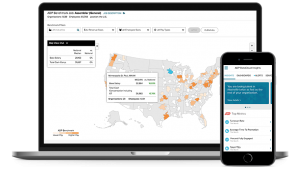 The client is a Fortune 500 company and provider of business process outsourcing and human capital management solutions. The company has revenues of $12B from 700,000 clients in 112 countries.
The client is a Fortune 500 company and provider of business process outsourcing and human capital management solutions. The company has revenues of $12B from 700,000 clients in 112 countries.
After conducting a strategic competitive analysis, Actionable Strategies was subsequently tasked with defining a product strategy for delivering products that provide predictive analytics. The client then asked us to build the initial product which won “Top HR Product” in HR Executive Magazine.
 Product Strategy
Product Strategy
To remain competitive with new entrants into the market, the company wanted to provide more advanced capabilities as part of their current product sets. Our competitive analysis and market research demonstrated a willingness to pay for advanced analytical capabilities. We utilized our Lean Product Development approach for the project lifecycle.
Product Development
Actionable Strategies worked with the client to identify predictive measures and other meaningful analytics and turn them into product offerings.
- Predict turnover in different parts of the business and determine potential actions
- Show how business measures of costs and revenue loss related to human capital factors such as attrition and overtime
- Align compensation with market measures including by geography
- Provide flexible views of workforce demographics
- Recruit effectively by providing insight into compensation and other metrics
- Analyze turnover, tenure, retention and other key indicators across different views of the business
Software Development
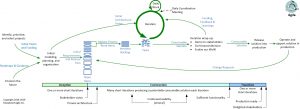 Essentially, Disciplined Agile Delivery was followed. Keys to success and other takeaways include:
Essentially, Disciplined Agile Delivery was followed. Keys to success and other takeaways include:
- Actionable Strategies conducted market research and competitive analysis to determine potential projects.
- New work items (stories) were added as part of the Lean Product Development process described above.
- The architecture served JSON objects to the browser, but used sample data until the middle tier could be built to transform cleansed production data.
- Evolving the WoW (way of working) involved reducing the iteration length to 1 week with the Chinese development team working late at night to collaborate with U.S. product stakeholders.
- The infrastructure evolved with all data and servers eventually moved into a Tier 1 production data center.
Results
Actionable Strategies collaborated closely with business and marketing leaders to conceive and build the product.
- The initial prototypes were well received by key customers, when previewed at trade shows, and to the press
- After formally launching the product, the client received the “Top HR Product” award by HR Executive Magazine
- The client immediately realized sales and testimonial customers from the enterprise segment of their business
- Actionable Strategies fully transitioned the Agile software development operation to the client IT organization when it was ready, from story cards to automated testing
- The client continued to extend the capabilities of the product into the mid-market segment, which is the most profitable area of their business
Today the client has a broad product offering and has elevated data delivery and analytics capabilities in their product and services mix.
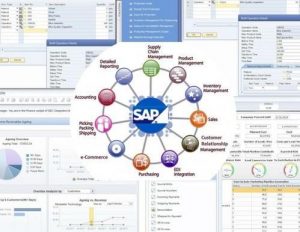 A very large enterprise in the Middle East needed a strategy for implementing ERP to consolidate their aging technologies onto a single, modern platform. The client selected Actionable Strategies because of the proven methodology proposed for enterprise platform selection with a project team experienced in large scale ERP package deployment in globally distributed organizations.
A very large enterprise in the Middle East needed a strategy for implementing ERP to consolidate their aging technologies onto a single, modern platform. The client selected Actionable Strategies because of the proven methodology proposed for enterprise platform selection with a project team experienced in large scale ERP package deployment in globally distributed organizations.
The client embraced the strategy, process changes and implementation plan, and was well-prepared as it launched the initiative.
Client Overview
 A very large enterprise in the Middle East needed a strategy for implementing ERP to consolidate their aging technologies onto a single, modern platform. The project is a result of sweeping change experienced across the Middle East including leadership and governance transitions at the confidential client which is part of the Kingdom of Saudi Arabia. The Middle East is experiencing tremendous growth in the technology sector.
A very large enterprise in the Middle East needed a strategy for implementing ERP to consolidate their aging technologies onto a single, modern platform. The project is a result of sweeping change experienced across the Middle East including leadership and governance transitions at the confidential client which is part of the Kingdom of Saudi Arabia. The Middle East is experiencing tremendous growth in the technology sector.
Business Problem
The client selected Actionable Strategies because of the proven methodology proposed for enterprise platform selection with a project team experienced in large scale ERP package deployment in globally distributed organizations.
Domains
The ERP Strategy required an analysis of critical needs related to:
- Human capital management
- Business processes and enterprise workflow
- Inventory
- Logistics
- Finance
- Technology
Cultural Challenges
Saudi Arabia poses a number of unique challenges based on culture, geography and the regulatory and governance frameworks. Our consultants needed to be well versed in dealing with cultural differences, including dealing with multiple languages and approaches to decision making and problem solving. The team needed to harmonize the client landscape to best practices.
Existing Technology
The client had a portfolio of legacy applications that would need to be decommissioned. However, they were wise enough not to seek change just for the sake of change. Clearly articulated business benefits would have to be a result. Therefore, our approach to introducing Lean processes implemented using best practices was highly attractive.
The underlying technologies were a mix of legacy IBM mainframe applications and point solutions using Microsoft technologies.
Solution Approach
Actionable Strategies applied a proven vendor evaluation methodology to rapidly drive a rational decision. This methodology has many embedded frameworks and has been applied to ERP platforms and large enterprises across a number of industries.
We then developed a realistic implementation plan and key considerations to ensure success. Most importantly, we provided consultative advice on achieving business benefits by introducing Lean processes as part of change management.
Platform Selection
Selecting the platform was an essential part of the project with numerous ramifications.
Knockout
 Initial screening of vendors provided for a quick elimination of vendors that were not suitable. This obviated the need for detailed analysis.
Initial screening of vendors provided for a quick elimination of vendors that were not suitable. This obviated the need for detailed analysis.
The following were the criteria that knocked out vendors who were not viable.
- Arabic language
- Local support for ongoing operations
- Enterprise class software
- Security appropriate for a highly sensitive industry
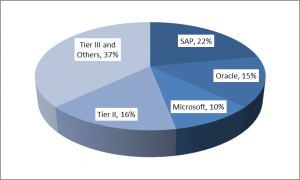 Vendor Analysis
Vendor Analysis
Vendors were analyzed based on a variety of factors. Reports from Industry Analysts were compiled and summarized. For example, market share was a consideration.
In this case, a short list was created that placed SAP head-to-head with Oracle.
Functional Analysis
 Scorecards were developed to identify the key functions that were important to the client. Weighting can vary by stakeholder and there are many functions that are part of ERP that do not fundamentally change the decision. This stakeholder input is captured and used during implementation.
Scorecards were developed to identify the key functions that were important to the client. Weighting can vary by stakeholder and there are many functions that are part of ERP that do not fundamentally change the decision. This stakeholder input is captured and used during implementation.
The detailed scoring is compiled across stakeholders and summarized by major function. These functions are then rolled up by the ERP module to which they belong. For this client the most vital features were rated as follows.
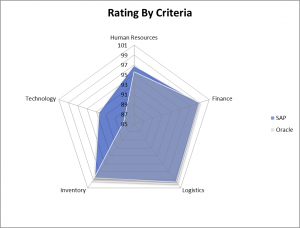
Technical Evaluation
 The underlying technology is important to the IT organization, but also has implications for end users. For this project, there were a number of key considerations around the technology.
The underlying technology is important to the IT organization, but also has implications for end users. For this project, there were a number of key considerations around the technology.
- Applications: Both vendors sought to expand their functional footprint by either building or buying applications that address needs not currently provided.
- Tools: Additional toolsets, especially around business intelligence which is driving significant revenue, are being rolled out.
- Foundation: The underlying application infrastructure continues to evolve support the needs of the additional products and the ability to integrate non-ERP applications.
Underlying Technologies
From a technical foundation perspective, Actionable Strategies evaluated the following areas critical to the client.
- Architecture
- Database
- Integration
Strategy and Roadmap
 For this client, it was important to decide which approach was most appropriate. Given the decade-plus time horizon, it was important to ascertain how the future state would impact the client. The two major vendors demonstrated different visions the essence of which was:
For this client, it was important to decide which approach was most appropriate. Given the decade-plus time horizon, it was important to ascertain how the future state would impact the client. The two major vendors demonstrated different visions the essence of which was:
- Oracle: Best-of-breed and acquired products with a pivot to the Cloud
- SAP: Tightly integrated
 Financial
Financial
Financial analysis was complex due to the variables in both licensing schemes. In addition, we looked at the total cost of ownership that incorporates the significant costs outside of the hardware and software purchases.
Implementation Approach
Actionable Strategies recommends that a structured process be followed to determine the best implementation approach. While go-live may be a single event, the underlying activities are best served as a series of interlinked projects run in a coordinated program. Where the as-is operations support it, a phased implementation has proven to be the least risky and most effective approach. However, when existing operations have tightly linked processes and technologies, the interim workarounds until enterprise go-live can be highly disruptive.
Process Best Practices
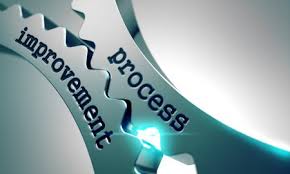 In evaluating the client processes, Actionable Strategies encouraged adoption of Lean processes. We advised the client to take full advantage of the required change management in implementing an ERP package to drive Lean given the fact that process change was inevitable.
In evaluating the client processes, Actionable Strategies encouraged adoption of Lean processes. We advised the client to take full advantage of the required change management in implementing an ERP package to drive Lean given the fact that process change was inevitable.
We also recommended that the client utilize best practices. Inefficient processes should be replaced with process best practices. SAP has many industry-tested processes already defined.
It was also noted that excessive customization or perpetuating existing inefficient processes is highly discouraged. Organizations that have not heeded this warning have experienced either catastrophic implementation failures or been forced to spend excessive resources and expenses in supporting all of the custom code and non-standard processes.
Project Planning: Time and Resources
For a successful implementation, it is essential that any ERP implementation have sufficient resources and time allocated. Trimming time and reducing resourcing during planning generally lead to delays and often create cost overruns as late resourcing constraints drive up costs. In a recent survey 61% of all ERP implementations reported being late.
The following table of average implementation times was used as a benchmark.
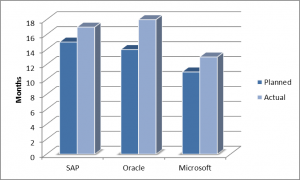
Acceptance Testing
While many implementation methodologies include testing to-be processes as part of acceptance testing, we recommend using the complete inventory of processes across the value chain. This includes both manual and automated processes, especially those interconnected processes that are:
- Upstream input
- Downstream dependent
Automated Testing
 Wherever possible it is recommended that automated testing be applied. The automated test bed yields payback in a number of scenarios.
Wherever possible it is recommended that automated testing be applied. The automated test bed yields payback in a number of scenarios.
- Change orders and rework in implementation
- Integrated with load and stress testing
- New module implementation
- Process change
- Data changes
- Regression testing during upgrades
- Regression testing when implementing or upgrading feeding or dependent systems
- Continuity of business testing
Business Continuity
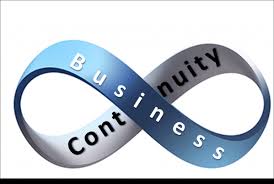 Process focused business continuity planning was recommended on top of basic disaster recovery planning. The complexity of an interconnected value chain implies that many systems and networks are vulnerable when a disaster is declared. The massive change involved clearly meant that existing continuity of business plans would become obsolete.
Process focused business continuity planning was recommended on top of basic disaster recovery planning. The complexity of an interconnected value chain implies that many systems and networks are vulnerable when a disaster is declared. The massive change involved clearly meant that existing continuity of business plans would become obsolete.
It was essential that periodic BCP tests include end-to-end process testing. Using the automated testbed built for project implementation makes this testing rapid, comprehensive and inexpensive.
![]() Based on the existing business, we were able to anticipate potential future needs.
Based on the existing business, we were able to anticipate potential future needs.
Global settings that might would likely be update included:
- Currencies
- Units of measurement
- ISO codes for EDI
- Calendars
- Time zones
- Financial Accounting: Business and Functional Areas
- Logistics: Locations
- Materials Management: Storage Locations
- Materials Management: Purchasing Organizations
- External Services
- Quality: Inspection
- Quality: Control
Business Results
 The client benefited from our depth of knowledge in business process, ERP planning and implementation, program and project management, and enterprise technology leadership. Actionable Strategies was able to provide guidance on Lean process innovation supported by Cloud computing models. The client embraced the strategy and was well-prepared to launch the initiative.
The client benefited from our depth of knowledge in business process, ERP planning and implementation, program and project management, and enterprise technology leadership. Actionable Strategies was able to provide guidance on Lean process innovation supported by Cloud computing models. The client embraced the strategy and was well-prepared to launch the initiative.


